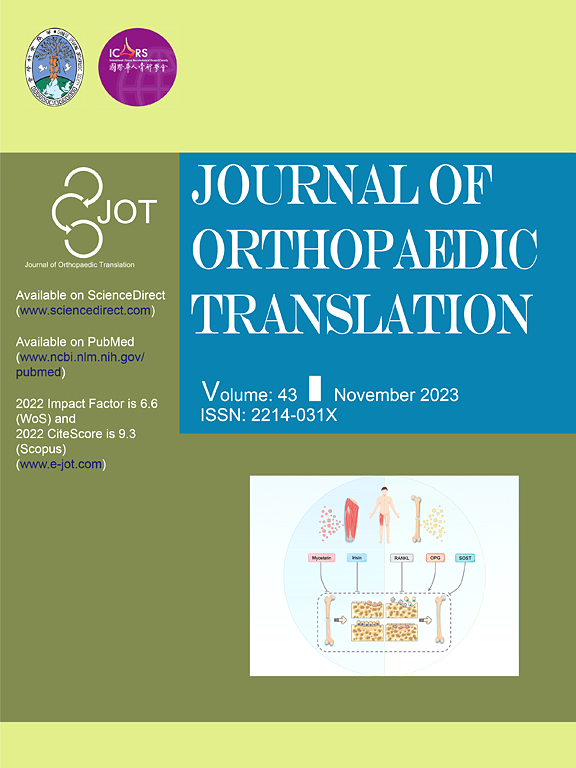巨噬细胞增多症促进骨相关疾病的破骨细胞分化
IF 5.9
1区 医学
Q1 ORTHOPEDICS
引用次数: 0
摘要
多核破骨细胞是骨吸收的主要特化细胞,但破骨细胞的形成需要大量的营养和生物能量。巨饮作用是代谢活跃细胞清除营养物质的有效途径;然而,在骨相关疾病中,代谢状态、破骨细胞分化和巨噬细胞增多之间的相互作用仍然知之甚少。方法采用小鼠骨髓源性巨噬细胞和RAW 264.7细胞诱导破骨细胞分化,探讨巨噬细胞在代谢调节中的作用。应用脂多糖(LPS)在体外模拟炎症条件,以评估巨噬细胞增多症对代谢谱和炎症相关破骨细胞生成的影响。此外,采用结扎性牙周炎和卵巢切除术(OVX)诱导的小鼠骨丢失模型来评估巨噬细胞增多症对骨吸收的体内影响。结果巨噬细胞增多促进破骨细胞形成,LPS进一步加速破骨细胞分化,增加巨噬细胞活性。这种上调有助于通过氧化磷酸化和糖酵解来满足破骨细胞生成的能量需求。(n -乙基- n -异丙基)酰胺(EIPA)抑制巨噬细胞增多症可减少能量产生并抑制破骨细胞分化。在牙周炎和OVX模型中也观察到巨噬细胞增多,其抑制导致骨量的早期剂量依赖性恢复。结论巨噬细胞作用是破骨细胞分化的重要能量来源。用EIPA靶向这一途径是治疗骨相关疾病的一种很有前途的方法。巨噬细胞的大量内吞过程为骨相关疾病的治疗提供了新的靶点。EIPA在抑制破骨细胞发生和骨吸收方面的作用提示其作为临床干预药物的潜力。本文章由计算机程序翻译,如有差异,请以英文原文为准。

Macropinocytosis fuels osteoclast differentiation in bone-related diseases
Objective
Multinucleated osteoclasts are the principal specialised cells responsible for bone resorption, but osteoclastogenesis, the formation of osteoclasts, entails substantial nutrient and bioenergetic demands. Macropinocytosis is an efficient pathway for nutrient scavenging in metabolically active cells; however, the interplay among metabolic state, osteoclast differentiation and macropinocytosis in bone-related diseases remains poorly understood.
Methods
In this study, osteoclast differentiation was induced using murine bone marrow-derived macrophages and RAW 264.7 cells to investigate the role of macropinocytosis in metabolic regulation. Lipopolysaccharide (LPS) was applied to mimic inflammatory conditions in vitro to assess the influence of macropinocytosis on both metabolic profiles and inflammation-associated osteoclastogenesis. Additionally, ligature-induced periodontitis and ovariectomy (OVX)-induced bone loss models in mice were employed to evaluate the in vivo impact of macropinocytosis on bone resorption.
Results
Enhanced macropinocytosis promoted osteoclast formation, with LPS further accelerating differentiation and increasing macropinocytic activity. This upregulation helped to meet the energy requirements of osteoclastogenesis via oxidative phosphorylation and glycolysis. Inhibition of macropinocytosis with (N-ethyl-N-isopropyl) amiloride (EIPA) reduced energy production and suppressed osteoclast differentiation. Elevated macropinocytosis was also observed in the periodontitis and OVX models, and its inhibition led to early, dose-dependent restoration of bone mass.
Conclusion
Macropinocytosis provides a critical energy source for osteoclast differentiation. Targeting this pathway with EIPA represents a promising therapeutic approach for bone-related diseases.
The translational potential of this article
As a bulk endocytic process, macropinocytosis offers a novel therapeutic target for bone-related diseases. The efficacy of EIPA in suppressing osteoclastogenesis and bone resorption suggests its potential as a clinical intervention drug.
求助全文
通过发布文献求助,成功后即可免费获取论文全文。
去求助
来源期刊

Journal of Orthopaedic Translation
Medicine-Orthopedics and Sports Medicine
CiteScore
11.80
自引率
13.60%
发文量
91
审稿时长
29 days
期刊介绍:
The Journal of Orthopaedic Translation (JOT) is the official peer-reviewed, open access journal of the Chinese Speaking Orthopaedic Society (CSOS) and the International Chinese Musculoskeletal Research Society (ICMRS). It is published quarterly, in January, April, July and October, by Elsevier.
 求助内容:
求助内容: 应助结果提醒方式:
应助结果提醒方式:


